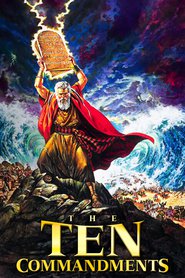
What can be said about a movie that one can watch during childhood with wonder and continue to watch time and time again, reviving that same childhood wonder on each subsequent viewing? Cecile B. DeMille’s epic rendering of the story of Moses, “The Ten Commandments”, is that film. This was the last film from a director who started making movies back in 1914. It was also a remake of his greatest triumph from the silent era. DeMille did not settle for what is told in the bible, but looked for various sources of information in order to tell a more complete and in depth story of the man who spoke to God and rescued the slaves from the great Egyptian empire. The story is universally known but DeMille made a great decision that regardless of the tales epic proportions and spiritual themes, he centered it on the deep conflict between brother and step brother. Man vs. Man. Moses vs Rameses II. Here is Jealousy and Love of such gargantuan proportions that their effects changed the world as we know it. It begins with the death of all newborn children and almost ends the same way. It is a story of not only faith but of destiny and power. At almost four hours long, the film lives up to its epic proportions and designs. Its story speaks to not only the Christian/Jewish faith but to all people striving for freedom. This is a freedom that needs to be contained by a constitution given to us by God. In centering its story on the life of Moses we have two distinct parts that mold into one and result in an awe inspiring understanding. The films first half is an action packed story of an action hero, who helps the weak and is all intelligent and capable. An adopted son of a thoughtful despot who turns his back on those he loved in order to face his true roots. Moses is an action hero, plain and simple. This is a strategy that DeMille first envisioned in his previous Bible film, “Samson and Delilah”. Moses is strong handsome and cunning as well as kind and gentle. The 2nd part of the movie is the Post burning bush part that transforms our physical action hero into a semi-god prophet with a long white beard and a god like voice. Charlton Heston would forever be known as Moses and a bigger than life figure after his superb performance in this film. It is this performance that allows both sections of the story to become believable. The acting in the film is first rate throughout and one of the finest aspects of the film is the ability of the actors to bring out their characters and have them stand out amidst a cast of hundreds. There is the powerful performance by Yul Brynner as Rameses II, who makes one actually believe that the Egyptian King has a Russian accent. He is almost Heston’s equal in physicality which helps in developing their conflict. It is this conflict that is the core of the story dealing with family love and tradition which is the human element that supersedes the biblical and spiritual ones. Ann Baxter as Nefretiri and Edward G. Robinson as Dathan, also stand out and bring their characters life. When he made this movie, DeMille had a great deal of power and clout in Hollywood. This allowed him an almost unlimited budget and the final film was at the time the most expensive movie ever made. The large budget allowed the movie to use hundreds of extras and to film on location in Egypt giving an almost realistic and clear vision to the fantastical tale. This greatly enhances the enjoyment of the movie. The special effects are outstanding, peaking with the spectacular parting of the red sea. That it was done without computers make the final effect even more spectacular. There is a real feeling of awe when watching these widescreen colorful scenes in High definition. The story of Moses is “The Ten Commandments”, and easily the greatest biblical movie ever made.

